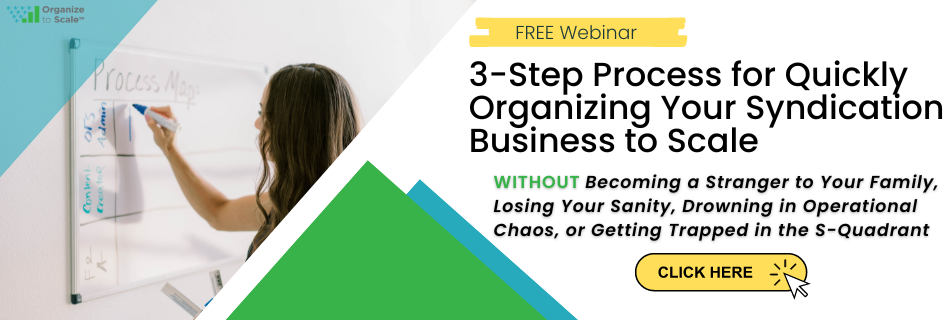Leveling Up: How to Go From Self-Employed to Business Owner
It’s simple really …
People build businesses for a few key reasons: to make money, to pursue their passion, to create freedom and to have a legitimate excuse for drinking copious amounts of coffee.
Okay, maybe that last one isn’t a primary reason.
But whether it’s to achieve financial freedom, create a product we believe in, or just enjoy the thrill of entrepreneurship, building a business can be a unique and rewarding experience.
When we say “building a business” what we actually mean is scaling a business.
What’s the difference?
Scaling a business comes with systems, people and processes which can be used to compound growth.
Building a business without those components, quite frankly makes us a glorified “jack-of-all-trades.”
Without the proper systems in place, many entrepreneurs quickly realize that rather than owning a business, they own a job … And they end up trapped instead of free.
If this sounds all-too familiar, don’t worry … You’re not alone. It’s something nearly all business owners face at one point or another in their entrepreneurial journey.
Robert Kiyosaki describes this as the “S-Quadrant” in his Cashflow quadrant model.
In this 4-Part diagram, Kiyosaki outlines the different types of income-generating activities and the roles individuals play in them …
- Employee (E) – Individuals who work for someone else and receive a paycheck for their time and effort. They have a job that provides them with a fixed salary, benefits, and “job security.” They trade their time for money and have limited control over their income.
- Self-Employed (S) – Individuals who work for themselves and are responsible for their own income. They typically have specialized skills or talents and work as consultants, freelancers, or small business owners. They have more control over their income than employees but also take on more if not all risk and responsibility.
- Business Owner (B) – Individuals who own a business that can operate without their direct involvement. They have a team of people who run the day-to-day operations, and the owner’s role is to provide strategic direction and oversee the business’s performance. They have more control over their income than both employees and self-employed individuals.
- Investor (I) – Individuals who generate income through investments, such as stocks, real estate, and other assets. They use their money to make money and have the potential for unlimited income and passive income streams. They have the most control over their income and can generate wealth through their investments.
What we at Organize to Scale™ have learned in our decades of business experience is that moving from Quadrant S to Quadrant B has proven to be the most difficult of all the transitions.
The GOOD news is that it doesn’t have to take you decades of trial and error to figure out how to free yourself from the S Quadrant … And become the proud owner of a thriving business that runs independently of you!
Starting a business is the first step. But if you want REAL freedom, you have to build the business in a way that fosters growth … And like any building, it all starts with a strong foundation.
So what’s the secret sauce to building a business you own that doesn’t own you? Systems, systems, systems!
High energy, type-A personalities tend to shudder when they hear that word since it typically calls for a “slow down to go faster” approach.
However, if we want to level up our businesses and escape the S Quadrant, we need to harness our energy into raising capital, building our brand, acquiring deals, managing processes, nurturing relationships, leading our team, and so much more.
We need to take methodical aligned actions.
And we simply cannot do this efficiently if we’re stuck in the hamster wheel of putting out fires!
But we don’t need to tell you how overwhelming things can get as a business owner without proper systems for every key function.
To operate a company at scale requires a team. It’s simply too much for one person to handle alone.
Which is why having “the right people in the right seats” should be our first order of business.
To do that, we need to start by identifying and attacking our biggest “pain point.” In other words, which one seat will make all of the other seats easier?
By doing this, we gain buy-in on our structures, infrastructures and systems by boosting the morale of our teams. They will begin to see that processes work and make everyone’s lives a little easier.
So, what exactly are the “right seats” anyway?
We all have things that energize us, and things that drain us.
As entrepreneurs, it’s common for us to enjoy things such as building our brand, building relationships, doing deals and strategic alliances.
On the other hand, our eyes tend to glaze over the second we’re asked to do anything clerical like filing, administrative functions or organizing in any capacity.
That’s because we all have our very own sweet spot. We get there by doing the tasks that come with no resistance, rather they keep us in flow.
They are a combination of the tasks we actually like doing, that also need to be done.
As business owners, we want the people on our teams to be in roles that align with their sweet spots.
Think of your business as an 18-wheeler, with each wheel representing a member of your team in their role.
If everyone is in their flow state, the ride will be smooth and effortless.
But if not, eventually our tires will become flat or imbalanced due to burnout. This will mean a rocky and unsafe journey for us and our team.
When a team of mission-driven leaders who share a harmonious vision come together, the load is lightened as everyone is working towards a common goal.
As leaders, we owe this level of cohesiveness to our team so as not to overload them.
By doing so, we empower our people to own their roles and keep them engaged. We promote a winning culture that keeps our businesses functioning like well-oiled machines with the power to combat quiet-quitting.
The right systems paired with the right people aligned towards the right goals is the secret sauce to move from the E/S to B/I side of the Cashflow Quadrant.
Now that we’ve got the secret sauce…
Are you ready to level up!?!
For Help Leveling Up and Scaling Your Business …
Author:
Staci Gray
Staci Gray has over two decades of experience organizing real-world businesses to scale. She puts an emphasis on quickly collapsing the gap between ideas and profits by persistently executing for progress and results. Staci envisions a world where innovative leaders are no longer trapped by operational chaos and instead are empowered to efficiently and effectively solve real-world problems, impact real-people on a human level and generate profits quickly. Staci loves coming alongside mission-driven leaders who are using their ideas, influence and intellect to build successful businesses and empowering them to scale without losing their sanity, compromising their values, sacrificing their relationships, and drowning in operational chaos. Supporting leaders one business at a time!





